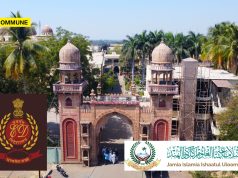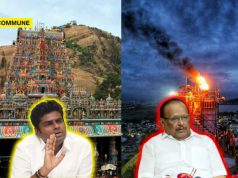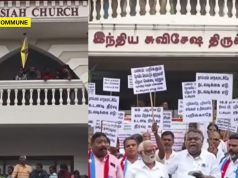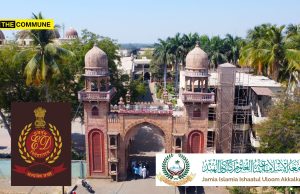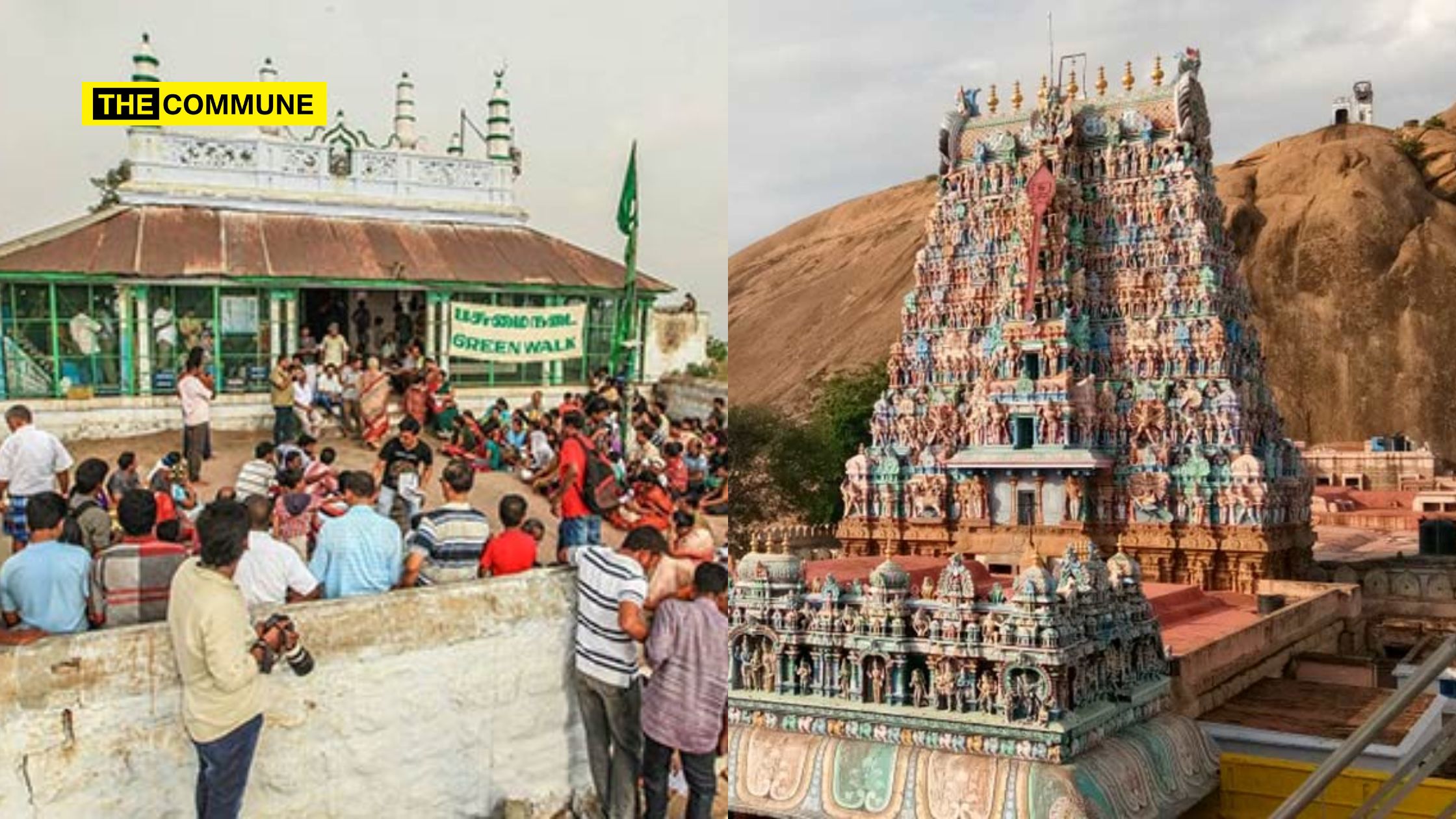
The Madras High Court has declined to prohibit the act of offering Namaz along a pathway leading to the Kasi Viswanathar Temple in Thirupparankundram, located in Madurai District.
Justices R Subramanian and L Victoria Gowri of the bench decided against issuing a temporary halt on the prayers at Nellithopu and requested the Hindu Religious & Charitable Endowment to present their response to the petition within a four-week period.
The court also expressed that there would be no harm caused by allowing 30 minutes of Namaz and assured that it would not inconvenience anyone.
The petition was initiated by Ramalingam, the State Organization Secretary of Aghila Bharatha Hanuman Sena. In his appeal, Ramalingam asserted that devotees who visited the Kasi Viswanathar Temple at the top of Thirupparakundram often took breaks and had their meals in the Nellithoppu area.
Furthermore, Ramalingam highlighted that the Jamath members usually performed their prayers at the Pallivasal Mosque, an incident that had never occurred before. He also pointed out the availability of other vacant lands in close proximity for conducting prayers.
According to Ramalingam’s submission, the Jamath members’ act of offering Namaz in Nellithopu caused disturbances and inconveniences to the public. He alleged that after the prayers, they left behind food waste and plastic, littering the pathway. Additionally, the Jamath members laid claim to the Thirupparakundram Arulmighu Subramania Swamy Thirukoil Mountain, referring to it as the “Sikkandar Mountain,” and he accused them of attempting to encroach on the land and create law and order issues.
However, despite the plea, the court was not inclined to grant an interim injunction and postponed the matter for further consideration.
About Thirupparankundram
Thiruparankundram holds great significance as one of the six sacred abodes of Hindu God Murugan. Alongside the Subramanya Swamy temple, the hill is home to rock-cut temples from the Pandya era, as well as historically important inscriptions and rock paintings.
During the oppressive rule of the Madurai Sultanate, many prominent temples in and around Madurai were deprived of regular rituals until Kumara Kampanna defeated the Sultanate. It is believed that Muslims constructed a dargah on Thiruparankundram hill during the Sultanate’s reign.
Muslims claim that Sikandar Zulqarnain, mentioned in the Quran, arrived in Madurai to preach, aid Muslim invaders, and establish their rule. They assert that he built a mosque on Thirupparankundram hill and died there while under attack. Consequently, they consider the hill their own and refer to it as ‘Sikkandar hill.’
History Of The Dispute
Hindu groups allege that under the pretext of celebrating festivals, Muslims have gradually encroached on other parts of the hill. These Hindu groups have long opposed these actions and have demanded that the government address the encroachment. The Subramanya Swamy temple, being under the control of Tamil Nadu HR&CE Department, has been accused of playing appeasement politics.
A Vijaya Bharatham article narrates the experience of a Hindu activist involved in reclaiming Hindu rights. It states that in the past, the Karthigai deepam (a ceremonial lighting of lamps) used to be lit at the stupa in the Kashi Vishwanath temple atop the hill. However, during World War II, the British banned this practice in Thiruparankundram, and it was never resumed even after India gained independence.
During this time, Muslims began encroaching on parts of the hill. They apparently buried the body of someone named Sikkandar and built a dargah. They also started referring to the hill as ‘Sikkandar hill’ and placed Islamic green crescent flags atop it. Chinna Karuppa Thevar, a Congress MLA at the time, gathered the public and removed those flags, replacing them with the national flag. He also initiated a hunger strike, resulting in the arrest of 700 protestors.
The then Chief Minister of the Madras presidency, T Prakasam, met with Chinna Karuppa Thevar and convinced him to end the strike, fearing potential law and order issues. Muslims claimed ownership of the hill’s area where the dargah is located and took the matter to court. The London Privy Council heard the case and ruled that the entire hill belongs to Subramanya Swamy and that the dargah should not be expanded in any way.
Subsequently, Madurai Rajagopal, the former President of Hindu Munnani, took steps to revive the tradition of lighting Karthigai Deepam at the stupa near the Kashi Vishwanath temple. He undertook a padayatra (foot march) to highlight this cause. When Muslims opposed the Vinayagar Chathurthi visarjan (immersion of Ganesha idols) in Keezhaarai, Ramanathapuram, Rajagopal led the procession. Enraged by his actions, Muslims murdered Rajagopal at his doorstep.
Petitions were filed in the Supreme Court to allow Hindus to light the Karthigai deepam on the hilltop and restore the tradition. The court ruled that the temple could light the deepam anywhere, as long as it was 15 meters away from the dargah. The stupa where the deepam is usually lit is located 100 meters from the dargah.
Although the Tamil Nadu government could have allowed the deepam to be lit at the same stupa, they chose to appease Muslims by lighting it at a spot 150 meters high near the Uchi Pillayar temple. This location is typically used for lighting moksha deepam for the deceased. To this day, Hindus continue to light moksha deepam at that spot. It is said that lighting the Karthigai deepam at a location reserved for moksha deepam goes against Agama rules.
Hindu Munnani has made efforts every year to revive the tradition. However, the government refuses permission, citing concerns over law and order. In 2020, a group of Hindu Munnani activists defied the government’s ban and lit the Karthigai deepam at the traditional spot. Two individuals were arrested for this act. A Times of India Tamil report confirms that the deepam was lit near the Kashi Vishwanath temple until 1967 and that the police consistently deny permission, providing various reasons.
It is alleged that Muslims have taken advantage of this situation and expanded their influence by performing Namaz on the pathway leading to the Kashi Vishwanath temple. In August 2021, a decision was taken at a meeting chaired by the District Collector to immediately remove the flagpole illegally erected by Sikandar Shah Dargah
(With inputs from Hindu Post and Live Law)
Click here to subscribe to The Commune on Telegram and get the best stories of the day delivered to you personally.

